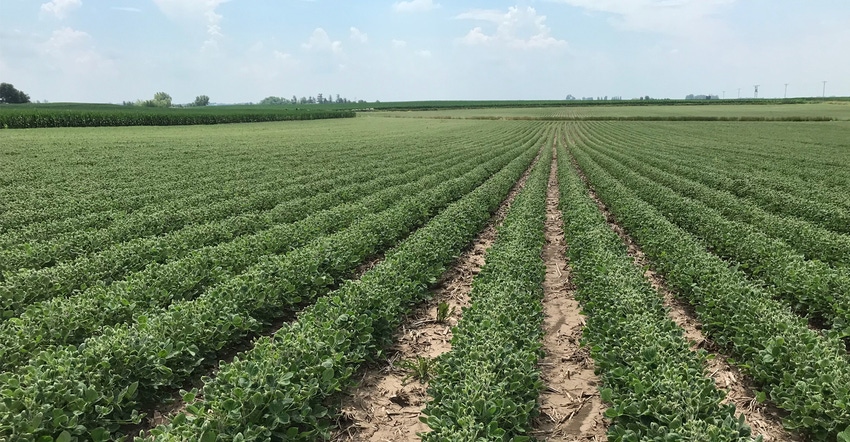August 5, 2021

In October 2020, EPA approved five-year registrations (until 2025) for dicamba products including XtendiMax (Bayer), Engenia (BASF) and Tavium (Syngenta) for over-the-top use in Xtend and XtendFlex soybeans. These new dicamba product registrations included national cutoff dates (June 30 in most cases) and mandatory use of additional volatility reduction agents (VRAs) in the tank.
Problem
Iowa State University Extension field agronomists and commercial agronomists in several areas of the state have reported a high percentage of non-dicamba-resistant soybean showing symptoms characteristic of dicamba, and in many fields the injury is fencerow to fencerow. This is the type of injury we have seen in previous years in Iowa and other adjacent states. Weed scientists in the Delta region used the term 'atmospheric loading.' Atmospheric loading refers to so much dicamba moving into the atmosphere that it is difficult, if not impossible, to identify the specific source or application that resulted in an injury to a field. More information on dicamba volatility can be found in this article from the Journal of Environmental Quality.
Speculations
There have been some rumors on social media and news articles from different sources that AMS (ammonium sulfate) and glufosinate can cause cupping under stress conditions. No peer-reviewed data suggest that AMS can cause leaf cupping in soybean. At higher rates or under hot and dry conditions, it may cause leaf burns, but not a cupping response. Nor will Liberty applications on glufosinate-tolerant or Enlist soybeans cause cupping. Moreover, we have been using AMS with glyphosate for past several years over millions of acres of glyphosate-tolerant soybeans, but no leaf cupping has been documented.
Also, we heard about the genetic response of Enlist soybeans to stress or Enlist (2,4-D choline) causing cupping. This is also not a valid speculation, as no such symptomology has been observed in research trials conducted in Enlist beans with over-the-top applications of Enlist over a wide range of environments. The 2,4-D symptomology on soybean is very much distinct from dicamba symptomology.
What happened in Iowa
This is what appears to have occurred across much of Iowa this summer:
1. The 2021 growing season was very dry to begin with, and the month of June was hot and dry, with temperatures well above 85 degrees F.
2. A majority of the postemergence dicamba applications occurred by the middle to the last week of June under those hot and dry conditions, ideal for off-target movement of dicamba through volatilization.
3. With less-than-optimum activity from soil-applied preemergence herbicides and slow growth of soybean under dry soil conditions this year, there was an additional burden on postemergence herbicides for controlling weeds in soybean fields. This might have resulted in large amounts of dicamba being applied to dicamba-tolerant soybeans in a small time period before the cutoff date of June 30, especially to control waterhemp.
4. Limited rainfall during this period left dicamba on soil and foliar surfaces for extended periods, where it is prone to volatilization during hot and dry periods.
5. If dicamba application occurs during a temperature inversion, small droplets are ‶trapped″ in the air above the ground and can move across the landscape, causing the symptomology to occur across several miles. It's hard to point out the source under this scenario.
6. Soybean reaches susceptible stages when early applications of dicamba are being made to corn.
Dicamba use and rates in corn have increased in recent years due to widespread occurrence of waterhemp populations resistant to Group 5 (atrazine), Group 9 (glyphosate) and Group 27 (HPPD inhibitors) herbicides. Nearly all dicamba formulations used in corn are higher in volatility than the formulations registered for use in dicamba-tolerant soybean.
Moving forward
With the rains that we have received recently, affected soybean plants with low levels of dicamba exposure are likely to outgrow the injury. Soybeans in V7 or R1 (just before flowering) are most sensitive to dicamba injury. It is apparent that environmental conditions play a significant role on the severity of this problem. Dicamba has become an important component of waterhemp resistance management program in soybean. Therefore, improved management practices are needed to mitigate off-target movement and preserve the utility of this product for waterhemp control in soybean.
Jha is an associate professor and Extension weed specialist at Iowa State University.
Source: ISU Integrated Crop Management, which is responsible for the information provided and is wholly owned by the source. Informa Business Media and its subsidiaries aren't responsible for any of the content contained in this information asset.
You May Also Like




